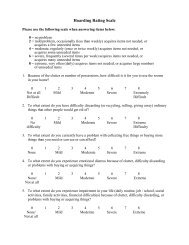
Fahn Tolosa Marin Tremor Rating Scale Pdf Plans
The majority of ET studies assess tremor with the Fahn–Tolosa–Marin Tremor Rating Scale (TRS) (Fahn et al., 1988). The TRS is a well established standardized 21-item tremor clinical rating scale in which tremor severity by body part is assessed. Related Medicare Advantage Policy Guideline: Deep Brain Stimulation for Essential Tremor and Parkinson's Disease (NCD 160.24) This information is being distributed to you for personal reference.
Abstract The standard assessment method for tremor severity in Parkinson’s disease is visual observation by neurologists using clinical rating scales. This is, therefore, a subjective rating that is dependent on clinical expertise. The objective of this study was to report clinicians’ tendencies to under-rate Parkinsonian tremors in the less affected hand. This was observed through objective tremor measurement with accelerometers. Tremor amplitudes were measured objectively using tri-axis-accelerometers for both hands simultaneously in 53 patients with Parkinson’s disease during resting and postural tremors.
The videotaped tremor was rated by neurologists using clinical rating scales. The tremor measured by accelerometer was compared with clinical ratings.
Neurologists tended to under-rate the less affected hand in resting tremor when the contralateral hand had severe tremor in Session I. The participating neurologists corrected this tendency in Session II after being informed of it. The under-rating tendency was then repeated by other uninformed neurologists in Session III.
Kappa statistics showed high inter-rater agreements and high agreements between estimated scores derived from the accelerometer signals and the mean Clinical Tremor Rating Scale evaluated in every session. Therefore, clinicians need to be aware of this under-rating tendency in visual inspection of the less affected hand in order to make accurate tremor severity assessments. Citation: Lee HJ, Kim SK, Park H, Kim HB, Jeon HS, Jung YJ, et al. (2015) Clinicians’ Tendencies to Under-Rate Parkinsonian Tremors in the Less Affected Hand. PLoS ONE 10(6): e0131703. Editor: Huaibin Cai, National Institute of Health, UNITED STATES Received: March 23, 2015; Accepted: June 4, 2015; Published: June 25, 2015 Copyright: © 2015 Lee et al.
This is an open access article distributed under the terms of the, which permits unrestricted use, distribution, and reproduction in any medium, provided the original author and source are credited Data Availability: All relevant data are within the paper. Funding: HJL, SKK, HYP, HBK, HSJ, BSJ, and KSP received grant support from the Ministry of Health and Welfare (No.
HI13C0455) and BK21 Plus Program through the National Research Foundation of Korea (NRF) funded by the Ministry of Education (grant numbers 1025) in the data collection. YJJ, ESO, HJK, and JYY received no specific funding for this work. Competing interests: All authors have declared that no competing interests exist. Introduction Tremor is defined as the involuntary and rhythmic oscillatory movement of a body part [].
Generally, tremor severities are subjectively assessed by clinicians through visual observation using clinical rating scales during neurological examination []. Tyagach voljvo prodazha v bishkeke. Various clinical rating scales are used to quantify resting, postural, and action tremors such as the Fahn-Tolosa-Marin Tremor Rating Scale (FTM TRS), the Unified Parkinson’s Disease Rating Scale (UPDRS), and the Clinical Tremor Rating Scale (CTRS) [–].
They provide clinicians with systems to rate the tremor severity of a body part during rest and movement on a five-point scale. However, since these are discrete and subjective ratings influenced by clinical expertise and personal bias [], there may be inter- and intra-individual differences. Several researchers developed tremor assessment methods using a variety of sensing technologies such as accelerometers, actigraphs, gyroscopes, electromagnetic tracking, and electromyography [, –]. These objective tests showed high correlations with clinical rating scales and high accuracy with low errors using analytical classifiers [,, ]. Moreover, a system integrating an accelerometer and a gyroscope has been used as a commercial product []. This paper aimed to demonstrate neurologists’ tendencies to under-rate Parkinsonian tremors in the less affected hand when the contralateral hand had severe tremor. In addition, we were particularly interested in whether this tendency was due to less attention to the less affected side, and whether the tendency was frequent among neurologists.